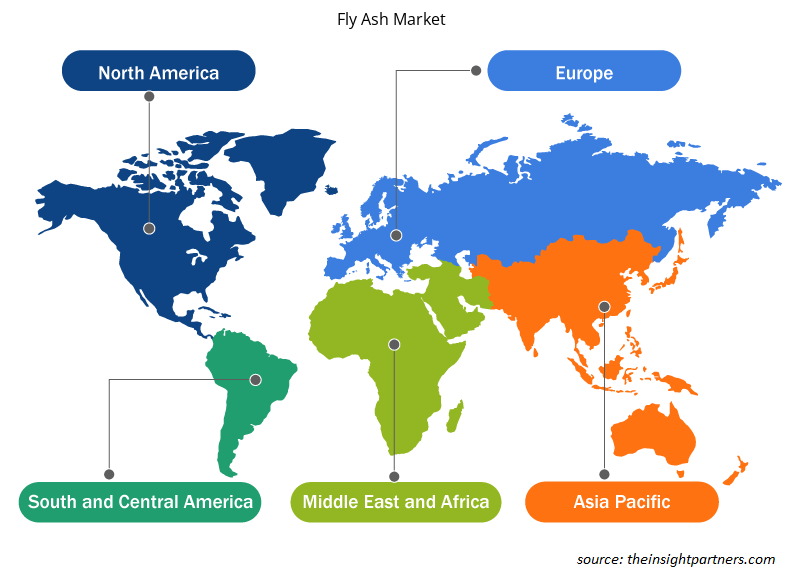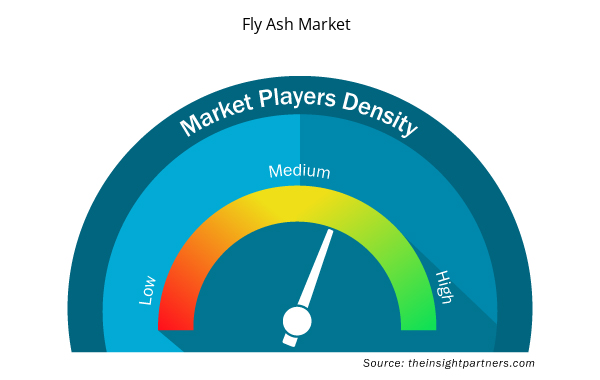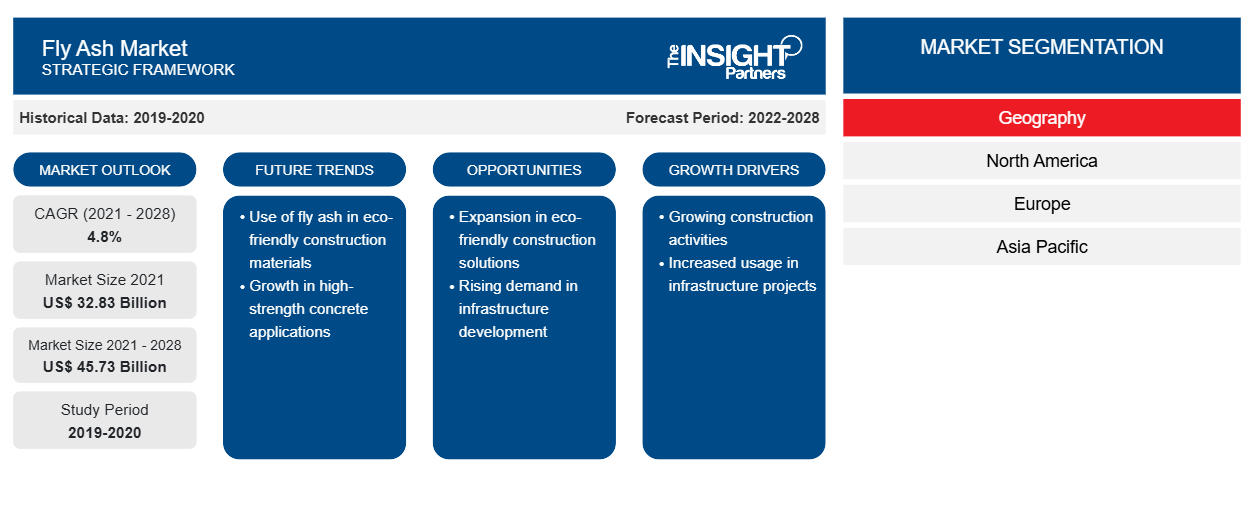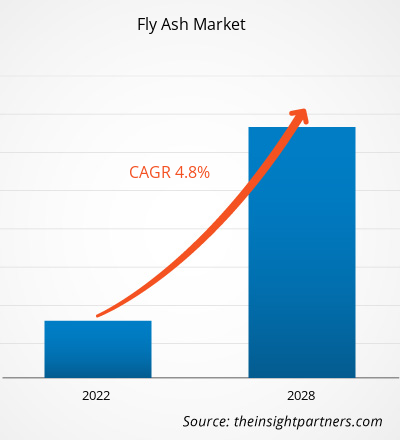[تقرير بحثي] تم تقييم سوق الرماد المتطاير بـ 32.83 مليار دولار أمريكي في عام 2021 ومن المتوقع أن يصل إلى 45.73 مليار دولار أمريكي بحلول عام 2028؛ ومن المتوقع أن ينمو بمعدل نمو سنوي مركب قدره 4.8٪ من عام 2021 إلى عام 2028.
تحليل السوق
يتم إنتاج الرماد المتطاير كبقايا في الاحتراق ويحتوي على جزيئات دقيقة مثل ثاني أكسيد السيليكون وأكسيد الألومنيوم وأكسيد الحديديك وأحيانًا أكسيد الكالسيوم. إنه مسحوق رمادي ناعم له خصائص بوزولانية ويمكنه التفاعل مع الجير لتكوين مركبات الأسمنت. يتم استخدامها في مجموعة واسعة من التطبيقات مثل خلط الأسمنت والخرسانة والمناجم والسدود ومكبات النفايات والخرسانة الجيوبوليمرية وغيرها. إنه يحسن أداء الخرسانة عند الخلط ويعمل أيضًا كمحفز لتحويل البولي إيثيلين أثناء التحلل الحراري .
محركات النمو والتحديات
إن النمو المستمر في صناعة البناء يعزز نمو سوق الرماد المتطاير العالمي بشكل كبير. تمتلك دول آسيا والمحيط الهادئ، مثل الولايات المتحدة والصين والهند، أكبر صناعة بناء في العالم. يخلق المعدل المرتفع لأنشطة البناء طلبًا هائلاً على مواد البناء المختلفة. يتم استخدام الرماد المتطاير في تطبيقات متعددة خاصة بالبناء، مثل الأسمنت والخرسانة والطوب والكتل. هناك استخدام متزايد للرماد المتطاير لمجموعة متنوعة من التطبيقات في صناعة البناء. علاوة على ذلك، فإن الاستخدام المتزايد للرماد المتطاير في تطبيقات مختلفة يعزز نمو سوق الرماد المتطاير العالمي. يتم استخدام الرماد المتطاير في تطبيقات مختلفة مثل الأسمنت والخرسانة والكتل والطوب والتعدين والحشوات والسدود وغيرها الكثير. نظرًا لخاصيته البوزولانية ، فإن استخدام الرماد المتطاير في الخرسانة مفيد للغاية، لأنه يحسن من متانة الخرسانة. في تصنيع خرسانة الأسمنت البورتلاندي، يتم استخدام الرماد المتطاير كمادة أسمنتية تكميلية ( SCM ) لتحسين أداء هذه الخرسانة. تُستخدم طوب الرماد المتطاير كمواد بناء بدلاً من الطوب الطيني. بالمقارنة مع الطوب الطيني التقليدي، فإن طوب الرماد المتطاير أخف وزناً وأكثر قوة، ومنخفض التكلفة، ولا يتطلب الجص، ويمكن أن يساعد في تقليل نفقات البناء وتآكل التربة. ومع ذلك، فإن الافتقار إلى الوعي بفوائد أو استخدامات الرماد المتطاير المحتملة، قد يحد من نمو سوقه. الرماد المتطاير مادة خام مهمة للعديد من التطبيقات. ومع ذلك، هناك نقص في فهم كيمياء الرماد المتطاير ومشتقاته لاستخدامها في التطبيقات النهائية المناسبة. يعد الافتقار إلى الوعي العام بالمنتجات أحد أسباب انخفاض استخدام الرماد المتطاير.
قم بتخصيص هذا التقرير ليناسب متطلباتك
ستحصل على تخصيص لأي تقرير - مجانًا - بما في ذلك أجزاء من هذا التقرير، أو تحليل على مستوى الدولة، وحزمة بيانات Excel، بالإضافة إلى الاستفادة من العروض والخصومات الرائعة للشركات الناشئة والجامعات
- احصل على أهم اتجاهات السوق الرئيسية لهذا التقرير.ستتضمن هذه العينة المجانية تحليلاً للبيانات، بدءًا من اتجاهات السوق وحتى التقديرات والتوقعات.
تقسيم التقرير ونطاقه
"تحليل سوق الرماد المتطاير العالمي حتى عام 2030" هو دراسة متخصصة ومتعمقة مع التركيز الرئيسي على اتجاهات سوق الرماد المتطاير العالمي وفرص النمو. يهدف التقرير إلى تقديم نظرة عامة على سوق الرماد المتطاير العالمي مع تقسيم السوق التفصيلي حسب النوع والتطبيق والجغرافيا. شهد سوق الرماد المتطاير العالمي نموًا مرتفعًا خلال الماضي القريب ومن المتوقع أن يستمر هذا الاتجاه خلال فترة التنبؤ. يقدم التقرير إحصائيات رئيسية عن استهلاك الرماد المتطاير في جميع أنحاء العالم جنبًا إلى جنب مع الطلب عليه في المناطق والبلدان الرئيسية. بالإضافة إلى ذلك، يقدم التقرير التقييم النوعي للعوامل المختلفة التي تؤثر على أداء سوق الرماد المتطاير في المناطق والبلدان الرئيسية. يتضمن التقرير أيضًا تحليلًا شاملاً للاعبين الرئيسيين في سوق الرماد المتطاير وتطوراتهم الاستراتيجية الرئيسية. يتم أيضًا تضمين العديد من التحليلات حول ديناميكيات السوق للمساعدة في تحديد العوامل الدافعة الرئيسية واتجاهات السوق وفرص سوق الرماد المتطاير المربحة والتي من شأنها بدورها أن تساعد في تحديد جيوب الإيرادات الرئيسية.
علاوة على ذلك، يوفر تحليل النظام البيئي وتحليل القوى الخمس لبورتر رؤية بزاوية 360 درجة لسوق الرماد المتطاير العالمي، مما يساعد على فهم سلسلة التوريد بأكملها والعوامل المختلفة التي تؤثر على نمو السوق.
التحليل القطاعي
يتم تقسيم سوق الرماد المتطاير العالمي على أساس النوع والتطبيق. بناءً على النوع، يتم تقسيم سوق الرماد المتطاير إلى النوع C والنوع F. على أساس التطبيق، يتم تصنيف السوق على أنها الأسمنت والخرسانة والكتل والطوب والتعدين وتثبيت الطرق والحشوات والسدود وتثبيت النفايات وغيرها. بناءً على النوع، استحوذت شريحة النوع C على حصة سوقية كبيرة من الرماد المتطاير والتي يمكن أن تُعزى إلى الاستخدام المتزايد للرماد المتطاير في تطبيقات مختلفة. غالبًا ما يتم الحصول على الرماد المتطاير من النوع C من الفحم شبه البيتوميني والليغنيت. ترجع خصائص التصلب الذاتي المميزة للرماد المتطاير من النوع C إلى تركيزه العالي من الجير الحي (CaO). الرماد المتطاير من النوع C هو الأفضل للمزائج عالية الأداء والتطبيقات المجهدة مسبقًا والتطبيقات الأخرى التي تتطلب قوى مبكرة أكبر. الرماد المتطاير من النوع C فعال للغاية في تثبيت التربة، نظرًا لمحتواه العالي من الجير. بناءً على التطبيق، استحوذ قطاع الأسمنت والخرسانة على حصة كبيرة من سوق الرماد المتطاير والتي يمكن أن تُعزى إلى زيادة استخدام الرماد المتطاير في قطاع البناء. يتم استخدام الرماد المتطاير كمادة أسمنتية تكميلية (SCM) لتصنيع خرسانة الأسمنت البورتلاندي. بالمقارنة مع خرسانة الأسمنت البورتلاندي ذات قابلية التشغيل نفسها، فإن استخدام الرماد المتطاير عالي الجودة مع دقة عالية ومحتوى منخفض من الكربون يقلل من الطلب على المياه للخرسانة. ونتيجة لذلك، يجب أن يسمح الرماد المتطاير بإنتاج الخرسانة بمحتوى مائي أقل. وهذا من شأنه أن يجذب المزيد من فرص النمو الجديدة لنمو الصناعة بشكل عام.
التحليل الإقليمي
يقدم التقرير نظرة عامة مفصلة على سوق الرماد المتطاير العالمي فيما يتعلق بخمس مناطق رئيسية، وهي؛ أمريكا الشمالية وأوروبا وآسيا والمحيط الهادئ (APAC) والشرق الأوسط وأفريقيا (MEA) وأمريكا الجنوبية والوسطى. شكلت منطقة الشرق الأوسط وأفريقيا حصة كبيرة من السوق وبلغت قيمتها أكثر من 600 مليون دولار أمريكي في عام 2022 ومن المتوقع أن تصل إلى ما يقرب من 1000 مليون دولار أمريكي في عام 2030. ساهمت الزيادة السريعة في أنشطة البناء، وخاصة في الشرق الأوسط، بشكل إيجابي في نمو السوق في الشرق الأوسط وأفريقيا. ومن المتوقع أيضًا أن تشهد منطقة آسيا والمحيط الهادئ نموًا كبيرًا بقيمة تزيد عن 25000 مليون دولار أمريكي في عام 2022، ويعزى ذلك إلى الاستخدام المتزايد للرماد المتطاير في تطبيقات مختلفة في المنطقة مما يدفع نمو سوق الرماد المتطاير العالمي. ومن المتوقع أيضًا أن تشهد أمريكا الشمالية نموًا كبيرًا بقيمة تزيد عن 4000 مليون دولار أمريكي في عام 2022، ويعزى ذلك إلى الاستخدام المتزايد للرماد المتطاير في صناعة البناء ومن المتوقع أن يعزز نمو سوق الرماد المتطاير العالمي.
تطورات الصناعة والفرص المستقبلية
وتبين أن الشراكات والاستحواذات وإطلاق المنتجات الجديدة هي الاستراتيجيات الرئيسية التي يتبناها اللاعبون العاملون في سوق الرماد المتطاير العالمي.
- في نوفمبر 2021، تعاقدت شركة لافارج هولسيم في الولايات المتحدة، وشركة جيوسايكل، ومركز بوينت إنيرجي، على إعادة تدوير رماد الفحم الناتج عن محطات الطاقة من مكبات النفايات لاستخدامه في تصنيع الأسمنت.
- في سبتمبر 2021، حصلت شركة Charah Solutions على عقد مبيعات وتسويق الرماد المتطاير لمدة 5 سنوات للاستخدام المفيد للرماد المتطاير الإنتاجي في محطة Gavin للطاقة في أوهايو.
تأثير كوفيد/ تأثير السيناريو الجيوسياسي/ تأثير الركود
أدى جائحة كوفيد-19 إلى تراجع تقدم العديد من الصناعات في جميع أنحاء العالم. أدى إغلاق مصانع التصنيع والتجارة المقيدة في جميع أنحاء العالم إلى قيود على سلسلة التوريد للمصنعين في جميع أنحاء العالم. لقد غير الوباء المستمر بشكل كبير وضع قطاع المواد الكيميائية والمواد وأثر سلبًا على نمو سوق الرماد المتطاير. أدى تنفيذ التدابير لمكافحة انتشار الفيروس إلى تفاقم الوضع وأثر على نمو العديد من القطاعات الصناعية. لم تكن العديد من محطات الطاقة الحرارية تعمل أو تعمل بطاقة أقل. وقد أثر هذا سلبًا على توليد الرماد المتطاير واستخدامه. لقد خلق الوباء أزمة صحية عالمية عطلت جميع الصناعات، بما في ذلك صناعة البناء. أدى انخفاض النشاط الاقتصادي إلى انخفاض الطلب على المرافق التجارية أو الصناعية الجديدة. أثر فقدان الدخل وانعدام ثقة المستهلك سلبًا على الطلب على بناء المساكن. كما واجهت مواقع البناء سلاسل إمداد معطلة وقيود تشغيلية. ومع ذلك، مع تخطيط الاقتصادات لإحياء عملياتها، من المتوقع أن يرتفع الطلب على الرماد المتطاير عالميًا. لذلك، تعافى سوق الرماد المتطاير بشكل جيد للغاية من آثار الوباء ومن المتوقع أن ينمو خلال السنوات القادمة.
رؤى إقليمية حول سوق الرماد المتطاير
لقد قام المحللون في Insight Partners بشرح الاتجاهات والعوامل الإقليمية المؤثرة على سوق الرماد المتطاير طوال فترة التوقعات بشكل شامل. يناقش هذا القسم أيضًا قطاعات سوق الرماد المتطاير والجغرافيا في جميع أنحاء أمريكا الشمالية وأوروبا ومنطقة آسيا والمحيط الهادئ والشرق الأوسط وأفريقيا وأمريكا الجنوبية والوسطى.

- احصل على البيانات الإقليمية المحددة لسوق الرماد المتطاير
نطاق تقرير سوق الرماد المتطاير
| سمة التقرير | تفاصيل |
|---|---|
| حجم السوق في عام 2021 | 32.83 مليار دولار أمريكي |
| حجم السوق بحلول عام 2028 | 45.73 مليار دولار أمريكي |
| معدل النمو السنوي المركب العالمي (2021 - 2028) | 4.8% |
| البيانات التاريخية | 2019-2020 |
| فترة التنبؤ | 2022-2028 |
| المناطق والدول المغطاة | أمريكا الشمالية
|
| قادة السوق وملفات تعريف الشركات الرئيسية |
|
كثافة اللاعبين في السوق: فهم تأثيرها على ديناميكيات الأعمال
يشهد سوق الرماد المتطاير نموًا سريعًا، مدفوعًا بالطلب المتزايد من المستخدم النهائي بسبب عوامل مثل تفضيلات المستهلكين المتطورة والتقدم التكنولوجي والوعي المتزايد بفوائد المنتج. ومع ارتفاع الطلب، تعمل الشركات على توسيع عروضها والابتكار لتلبية احتياجات المستهلكين والاستفادة من الاتجاهات الناشئة، مما يؤدي إلى زيادة نمو السوق.
تشير كثافة اللاعبين في السوق إلى توزيع الشركات أو المؤسسات العاملة في سوق أو صناعة معينة. وهي تشير إلى عدد المنافسين (اللاعبين في السوق) الموجودين في مساحة سوق معينة نسبة إلى حجمها أو قيمتها السوقية الإجمالية.
الشركات الرئيسية العاملة في سوق الرماد المتطاير هي:
- بورال
- شركة سيمكس ذات السيرة الذاتية
- هولسيم
- إدارة النفايات، المحدودة
- شركة شاراه للحلول
إخلاء المسؤولية : الشركات المذكورة أعلاه ليست مرتبة بأي ترتيب معين.

- احصل على نظرة عامة على أهم اللاعبين الرئيسيين في سوق الرماد المتطاير
المشهد التنافسي والشركات الرئيسية
تشمل بعض اللاعبين الرئيسيين العاملين في سوق الرماد المتطاير شركة Boral LTD.، وCemex SAB DE CV، وLafargeholcim Ltd.، وWaste Management, Inc.، وCharah, LLC، وSeparation Technologies LLC، وCement Australia PTY Limited، وSalt River Materials Group، وAshtech India Pvt. Ltd.، وDuromar, Inc. وغيرها.
- التحليل التاريخي (سنتان)، السنة الأساسية، التوقعات (7 سنوات) مع معدل النمو السنوي المركب
- تحليل PEST و SWOT
- حجم السوق والقيمة / الحجم - عالميًا وإقليميًا وقطريًا
- الصناعة والمنافسة
- مجموعة بيانات Excel


- Employment Screening Services Market
- Microplate Reader Market
- Molecular Diagnostics Market
- Transdermal Drug Delivery System Market
- Long Read Sequencing Market
- Nitrogenous Fertilizer Market
- Adaptive Traffic Control System Market
- Gas Engine Market
- Virtual Pipeline Systems Market
- Hydrogen Compressors Market

Report Coverage
Revenue forecast, Company Analysis, Industry landscape, Growth factors, and Trends

Segment Covered
This text is related
to segments covered.

Regional Scope
North America, Europe, Asia Pacific, Middle East & Africa, South & Central America

Country Scope
This text is related
to country scope.
الأسئلة الشائعة
The cement and concrete segment held the largest share of the market in 2021. Fly ash is used as a supplementary cementitious material (SCM) to manufacture Portland cement concrete. Compared to Portland cement concrete of the same workability, the use of excellent-quality fly ash with high fineness and low carbon content reduces the water demand of concrete. Moreover, the heat of hydration of concrete can be reduced by replacing cement with the same quantity of fly ash.
The major players operating in the global fly ash market are Boral; CEMEX S.A.B. DE C.V.; HOLCIM; Waste Management, Inc.; Charah Solutions, Inc.; Salt River Materials Group; Cement Australia Pty Limited; Ashtech India Pvt. Ltd.; Titan America, LLC.; Aceton Industries, LLP; among others.
In 2021, Asia Pacific held the largest share of the global fly ash market. The market growth in this region is attributed to increasing infrastructural developments, such as the development of rail networks, fly overs, and highways; rising activities in residential and commercial construction; and high emphasis of governments and other regulatory bodies on recycling and reutilizing fly ash. Governments in countries such as India, China, and Japan have taken various initiatives to save energy and avoid dumping fly ash into landfills and ponds, resulting in the increased use of fly ash in concrete and Portland cement.
The type C fly ash segment held the largest share of the global fly ash market in 2021. Type C fly ash is often obtained from sub-bituminous and lignite coal. Type C fly ash's distinctive self-hardening properties are due to its high quicklime (CaO) concentration. Type C fly ash is best for performance blends, pre-stressed applications, and other applications that require greater early strengths.
The cement and concrete segment is the fastest growing segment in the global fly ash market during the forecasted period. The rapid popularity of using fly ash in concrete to achieve high-performance and strength is one of the crucial factors driving the market for the cement and concrete segment.
Asia Pacific is estimated to register the fastest CAGR in the global fly ash market over the forecast period. The growth of the fly ash market in Asia-Pacific is driven by rising government infrastructural development projects and increasing utilization of fly ash-based concrete for the construction of new infrastructures in the region.
The List of Companies - Fly Ash Market
- Boral
- CEMEX S.A.B. DE C.V.
- HOLCIM
- Waste Management, Inc.
- Charah Solutions, Inc.
- Salt River Materials Group
- Cement Australia Pty Limited
- Ashtech India Pvt. Ltd
- Titan America, LLC.
- Aceton Industries, LLP
The Insight Partners performs research in 4 major stages: Data Collection & Secondary Research, Primary Research, Data Analysis and Data Triangulation & Final Review.
- Data Collection and Secondary Research:
As a market research and consulting firm operating from a decade, we have published and advised several client across the globe. First step for any study will start with an assessment of currently available data and insights from existing reports. Further, historical and current market information is collected from Investor Presentations, Annual Reports, SEC Filings, etc., and other information related to company’s performance and market positioning are gathered from Paid Databases (Factiva, Hoovers, and Reuters) and various other publications available in public domain.
Several associations trade associates, technical forums, institutes, societies and organization are accessed to gain technical as well as market related insights through their publications such as research papers, blogs and press releases related to the studies are referred to get cues about the market. Further, white papers, journals, magazines, and other news articles published in last 3 years are scrutinized and analyzed to understand the current market trends.
- Primary Research:
The primarily interview analysis comprise of data obtained from industry participants interview and answers to survey questions gathered by in-house primary team.
For primary research, interviews are conducted with industry experts/CEOs/Marketing Managers/VPs/Subject Matter Experts from both demand and supply side to get a 360-degree view of the market. The primary team conducts several interviews based on the complexity of the markets to understand the various market trends and dynamics which makes research more credible and precise.
A typical research interview fulfils the following functions:
- Provides first-hand information on the market size, market trends, growth trends, competitive landscape, and outlook
- Validates and strengthens in-house secondary research findings
- Develops the analysis team’s expertise and market understanding
Primary research involves email interactions and telephone interviews for each market, category, segment, and sub-segment across geographies. The participants who typically take part in such a process include, but are not limited to:
- Industry participants: VPs, business development managers, market intelligence managers and national sales managers
- Outside experts: Valuation experts, research analysts and key opinion leaders specializing in the electronics and semiconductor industry.
Below is the breakup of our primary respondents by company, designation, and region:

Once we receive the confirmation from primary research sources or primary respondents, we finalize the base year market estimation and forecast the data as per the macroeconomic and microeconomic factors assessed during data collection.
- Data Analysis:
Once data is validated through both secondary as well as primary respondents, we finalize the market estimations by hypothesis formulation and factor analysis at regional and country level.
- Macro-Economic Factor Analysis:
We analyse macroeconomic indicators such the gross domestic product (GDP), increase in the demand for goods and services across industries, technological advancement, regional economic growth, governmental policies, the influence of COVID-19, PEST analysis, and other aspects. This analysis aids in setting benchmarks for various nations/regions and approximating market splits. Additionally, the general trend of the aforementioned components aid in determining the market's development possibilities.
- Country Level Data:
Various factors that are especially aligned to the country are taken into account to determine the market size for a certain area and country, including the presence of vendors, such as headquarters and offices, the country's GDP, demand patterns, and industry growth. To comprehend the market dynamics for the nation, a number of growth variables, inhibitors, application areas, and current market trends are researched. The aforementioned elements aid in determining the country's overall market's growth potential.
- Company Profile:
The “Table of Contents” is formulated by listing and analyzing more than 25 - 30 companies operating in the market ecosystem across geographies. However, we profile only 10 companies as a standard practice in our syndicate reports. These 10 companies comprise leading, emerging, and regional players. Nonetheless, our analysis is not restricted to the 10 listed companies, we also analyze other companies present in the market to develop a holistic view and understand the prevailing trends. The “Company Profiles” section in the report covers key facts, business description, products & services, financial information, SWOT analysis, and key developments. The financial information presented is extracted from the annual reports and official documents of the publicly listed companies. Upon collecting the information for the sections of respective companies, we verify them via various primary sources and then compile the data in respective company profiles. The company level information helps us in deriving the base number as well as in forecasting the market size.
- Developing Base Number:
Aggregation of sales statistics (2020-2022) and macro-economic factor, and other secondary and primary research insights are utilized to arrive at base number and related market shares for 2022. The data gaps are identified in this step and relevant market data is analyzed, collected from paid primary interviews or databases. On finalizing the base year market size, forecasts are developed on the basis of macro-economic, industry and market growth factors and company level analysis.
- Data Triangulation and Final Review:
The market findings and base year market size calculations are validated from supply as well as demand side. Demand side validations are based on macro-economic factor analysis and benchmarks for respective regions and countries. In case of supply side validations, revenues of major companies are estimated (in case not available) based on industry benchmark, approximate number of employees, product portfolio, and primary interviews revenues are gathered. Further revenue from target product/service segment is assessed to avoid overshooting of market statistics. In case of heavy deviations between supply and demand side values, all thes steps are repeated to achieve synchronization.
We follow an iterative model, wherein we share our research findings with Subject Matter Experts (SME’s) and Key Opinion Leaders (KOLs) until consensus view of the market is not formulated – this model negates any drastic deviation in the opinions of experts. Only validated and universally acceptable research findings are quoted in our reports.
We have important check points that we use to validate our research findings – which we call – data triangulation, where we validate the information, we generate from secondary sources with primary interviews and then we re-validate with our internal data bases and Subject matter experts. This comprehensive model enables us to deliver high quality, reliable data in shortest possible time.


 احصل على عينة مجانية لهذا التقرير
احصل على عينة مجانية لهذا التقرير